Comparative Analysis: Business Ethics and Social Responsibility Report
VerifiedAdded on 2019/11/19
|11
|3547
|280
Report
AI Summary
This report provides a comprehensive analysis of the 'Insider Trading at the Galleon Group' case, focusing on the ethical and legal ramifications of fraudulent accounting practices. The report begins with an executive summary highlighting the key issues, including the downfall of the Galleon Group due to insider trading activities led by its co-founder, Rajaratnam. It emphasizes the significance of ethics and legality in the stock market and the challenges in deterring insider trading despite regulations. The introduction provides an overview of the case, detailing the insider trading activities and the penalties imposed by regulatory bodies. The report further evaluates the information-gathering techniques used by Rajaratnam and the prevalence of such practices on Wall Street, as well as the implications of sharing confidential material information. It discusses the need for stricter monitoring by regulators, the importance of investor due diligence, and the role of executives in maintaining ethical conduct. The report also examines the implications of sharing confidential information, including monetary penalties, loss of goodwill, and legal repercussions. The analysis underscores the importance of ethical behavior in financial markets and the need for adherence to regulations to prevent insider trading and protect investor interests. The report uses the utilitarian theory of ethics and behavioral finance to support the analysis, highlighting the unethical nature of insider trading and its negative impact on market efficiency.
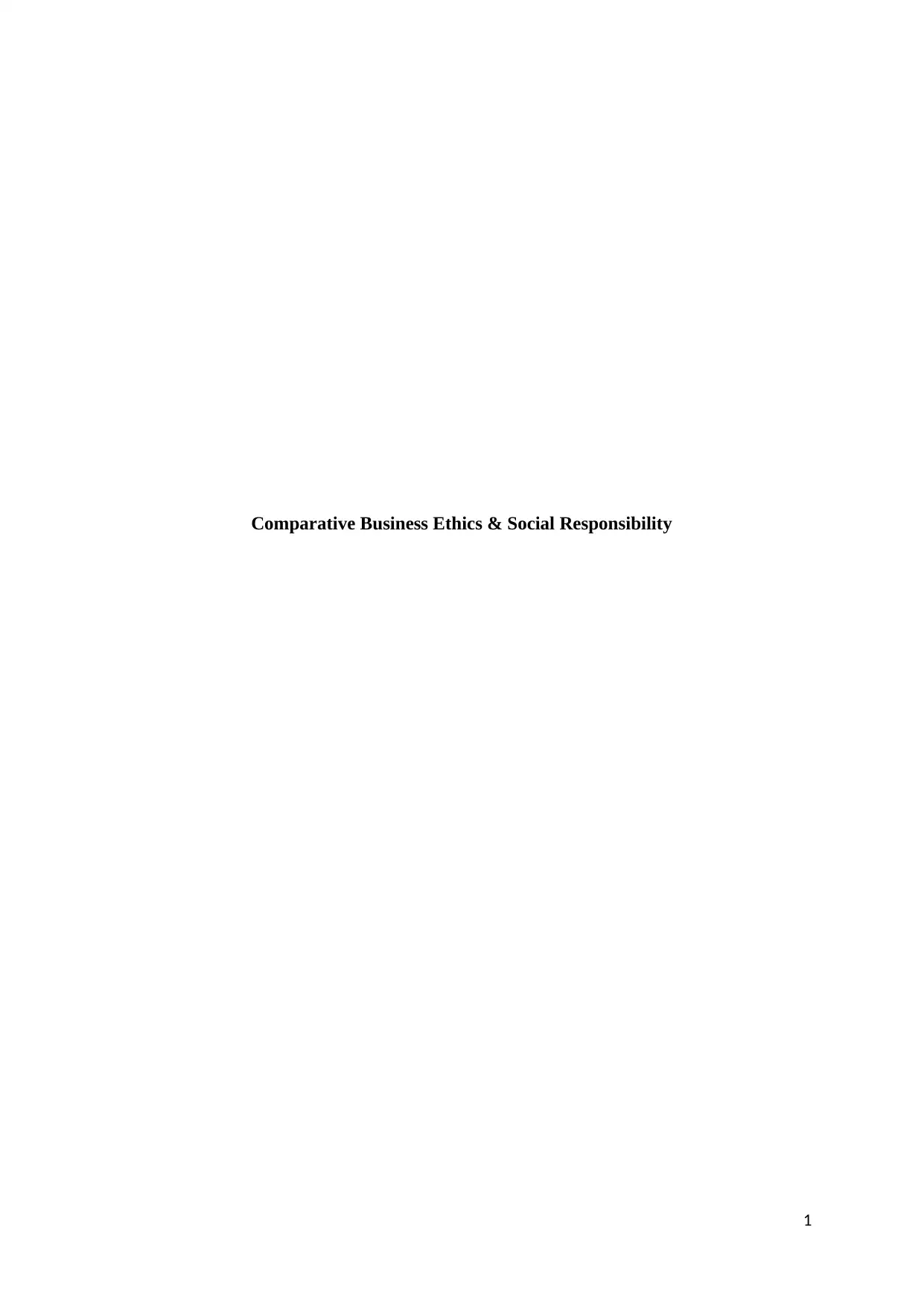
Comparative Business Ethics & Social Responsibility
1
1
Paraphrase This Document
Need a fresh take? Get an instant paraphrase of this document with our AI Paraphraser
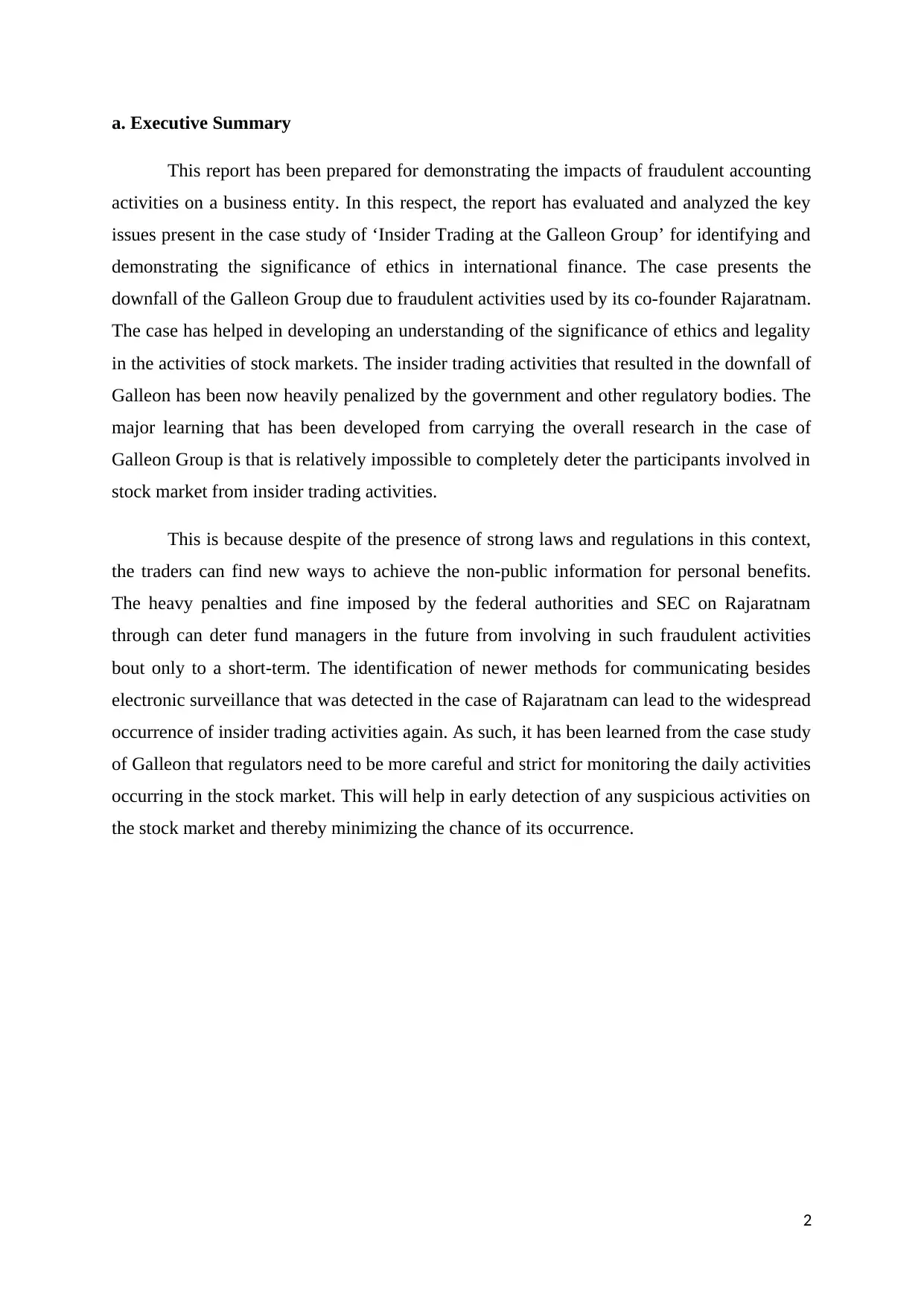
a. Executive Summary
This report has been prepared for demonstrating the impacts of fraudulent accounting
activities on a business entity. In this respect, the report has evaluated and analyzed the key
issues present in the case study of ‘Insider Trading at the Galleon Group’ for identifying and
demonstrating the significance of ethics in international finance. The case presents the
downfall of the Galleon Group due to fraudulent activities used by its co-founder Rajaratnam.
The case has helped in developing an understanding of the significance of ethics and legality
in the activities of stock markets. The insider trading activities that resulted in the downfall of
Galleon has been now heavily penalized by the government and other regulatory bodies. The
major learning that has been developed from carrying the overall research in the case of
Galleon Group is that is relatively impossible to completely deter the participants involved in
stock market from insider trading activities.
This is because despite of the presence of strong laws and regulations in this context,
the traders can find new ways to achieve the non-public information for personal benefits.
The heavy penalties and fine imposed by the federal authorities and SEC on Rajaratnam
through can deter fund managers in the future from involving in such fraudulent activities
bout only to a short-term. The identification of newer methods for communicating besides
electronic surveillance that was detected in the case of Rajaratnam can lead to the widespread
occurrence of insider trading activities again. As such, it has been learned from the case study
of Galleon that regulators need to be more careful and strict for monitoring the daily activities
occurring in the stock market. This will help in early detection of any suspicious activities on
the stock market and thereby minimizing the chance of its occurrence.
2
This report has been prepared for demonstrating the impacts of fraudulent accounting
activities on a business entity. In this respect, the report has evaluated and analyzed the key
issues present in the case study of ‘Insider Trading at the Galleon Group’ for identifying and
demonstrating the significance of ethics in international finance. The case presents the
downfall of the Galleon Group due to fraudulent activities used by its co-founder Rajaratnam.
The case has helped in developing an understanding of the significance of ethics and legality
in the activities of stock markets. The insider trading activities that resulted in the downfall of
Galleon has been now heavily penalized by the government and other regulatory bodies. The
major learning that has been developed from carrying the overall research in the case of
Galleon Group is that is relatively impossible to completely deter the participants involved in
stock market from insider trading activities.
This is because despite of the presence of strong laws and regulations in this context,
the traders can find new ways to achieve the non-public information for personal benefits.
The heavy penalties and fine imposed by the federal authorities and SEC on Rajaratnam
through can deter fund managers in the future from involving in such fraudulent activities
bout only to a short-term. The identification of newer methods for communicating besides
electronic surveillance that was detected in the case of Rajaratnam can lead to the widespread
occurrence of insider trading activities again. As such, it has been learned from the case study
of Galleon that regulators need to be more careful and strict for monitoring the daily activities
occurring in the stock market. This will help in early detection of any suspicious activities on
the stock market and thereby minimizing the chance of its occurrence.
2
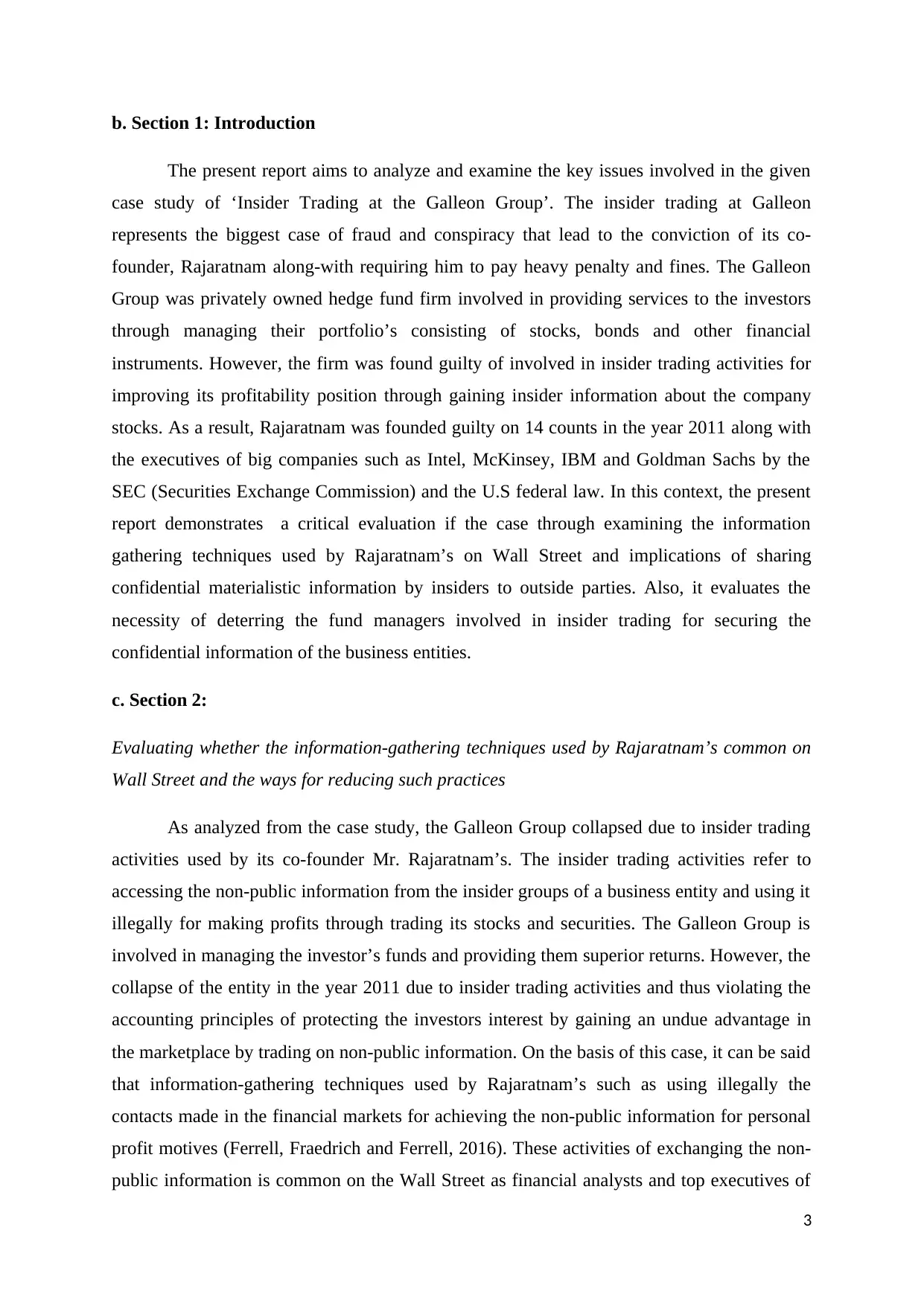
b. Section 1: Introduction
The present report aims to analyze and examine the key issues involved in the given
case study of ‘Insider Trading at the Galleon Group’. The insider trading at Galleon
represents the biggest case of fraud and conspiracy that lead to the conviction of its co-
founder, Rajaratnam along-with requiring him to pay heavy penalty and fines. The Galleon
Group was privately owned hedge fund firm involved in providing services to the investors
through managing their portfolio’s consisting of stocks, bonds and other financial
instruments. However, the firm was found guilty of involved in insider trading activities for
improving its profitability position through gaining insider information about the company
stocks. As a result, Rajaratnam was founded guilty on 14 counts in the year 2011 along with
the executives of big companies such as Intel, McKinsey, IBM and Goldman Sachs by the
SEC (Securities Exchange Commission) and the U.S federal law. In this context, the present
report demonstrates a critical evaluation if the case through examining the information
gathering techniques used by Rajaratnam’s on Wall Street and implications of sharing
confidential materialistic information by insiders to outside parties. Also, it evaluates the
necessity of deterring the fund managers involved in insider trading for securing the
confidential information of the business entities.
c. Section 2:
Evaluating whether the information-gathering techniques used by Rajaratnam’s common on
Wall Street and the ways for reducing such practices
As analyzed from the case study, the Galleon Group collapsed due to insider trading
activities used by its co-founder Mr. Rajaratnam’s. The insider trading activities refer to
accessing the non-public information from the insider groups of a business entity and using it
illegally for making profits through trading its stocks and securities. The Galleon Group is
involved in managing the investor’s funds and providing them superior returns. However, the
collapse of the entity in the year 2011 due to insider trading activities and thus violating the
accounting principles of protecting the investors interest by gaining an undue advantage in
the marketplace by trading on non-public information. On the basis of this case, it can be said
that information-gathering techniques used by Rajaratnam’s such as using illegally the
contacts made in the financial markets for achieving the non-public information for personal
profit motives (Ferrell, Fraedrich and Ferrell, 2016). These activities of exchanging the non-
public information is common on the Wall Street as financial analysts and top executives of
3
The present report aims to analyze and examine the key issues involved in the given
case study of ‘Insider Trading at the Galleon Group’. The insider trading at Galleon
represents the biggest case of fraud and conspiracy that lead to the conviction of its co-
founder, Rajaratnam along-with requiring him to pay heavy penalty and fines. The Galleon
Group was privately owned hedge fund firm involved in providing services to the investors
through managing their portfolio’s consisting of stocks, bonds and other financial
instruments. However, the firm was found guilty of involved in insider trading activities for
improving its profitability position through gaining insider information about the company
stocks. As a result, Rajaratnam was founded guilty on 14 counts in the year 2011 along with
the executives of big companies such as Intel, McKinsey, IBM and Goldman Sachs by the
SEC (Securities Exchange Commission) and the U.S federal law. In this context, the present
report demonstrates a critical evaluation if the case through examining the information
gathering techniques used by Rajaratnam’s on Wall Street and implications of sharing
confidential materialistic information by insiders to outside parties. Also, it evaluates the
necessity of deterring the fund managers involved in insider trading for securing the
confidential information of the business entities.
c. Section 2:
Evaluating whether the information-gathering techniques used by Rajaratnam’s common on
Wall Street and the ways for reducing such practices
As analyzed from the case study, the Galleon Group collapsed due to insider trading
activities used by its co-founder Mr. Rajaratnam’s. The insider trading activities refer to
accessing the non-public information from the insider groups of a business entity and using it
illegally for making profits through trading its stocks and securities. The Galleon Group is
involved in managing the investor’s funds and providing them superior returns. However, the
collapse of the entity in the year 2011 due to insider trading activities and thus violating the
accounting principles of protecting the investors interest by gaining an undue advantage in
the marketplace by trading on non-public information. On the basis of this case, it can be said
that information-gathering techniques used by Rajaratnam’s such as using illegally the
contacts made in the financial markets for achieving the non-public information for personal
profit motives (Ferrell, Fraedrich and Ferrell, 2016). These activities of exchanging the non-
public information is common on the Wall Street as financial analysts and top executives of
3
⊘ This is a preview!⊘
Do you want full access?
Subscribe today to unlock all pages.

Trusted by 1+ million students worldwide
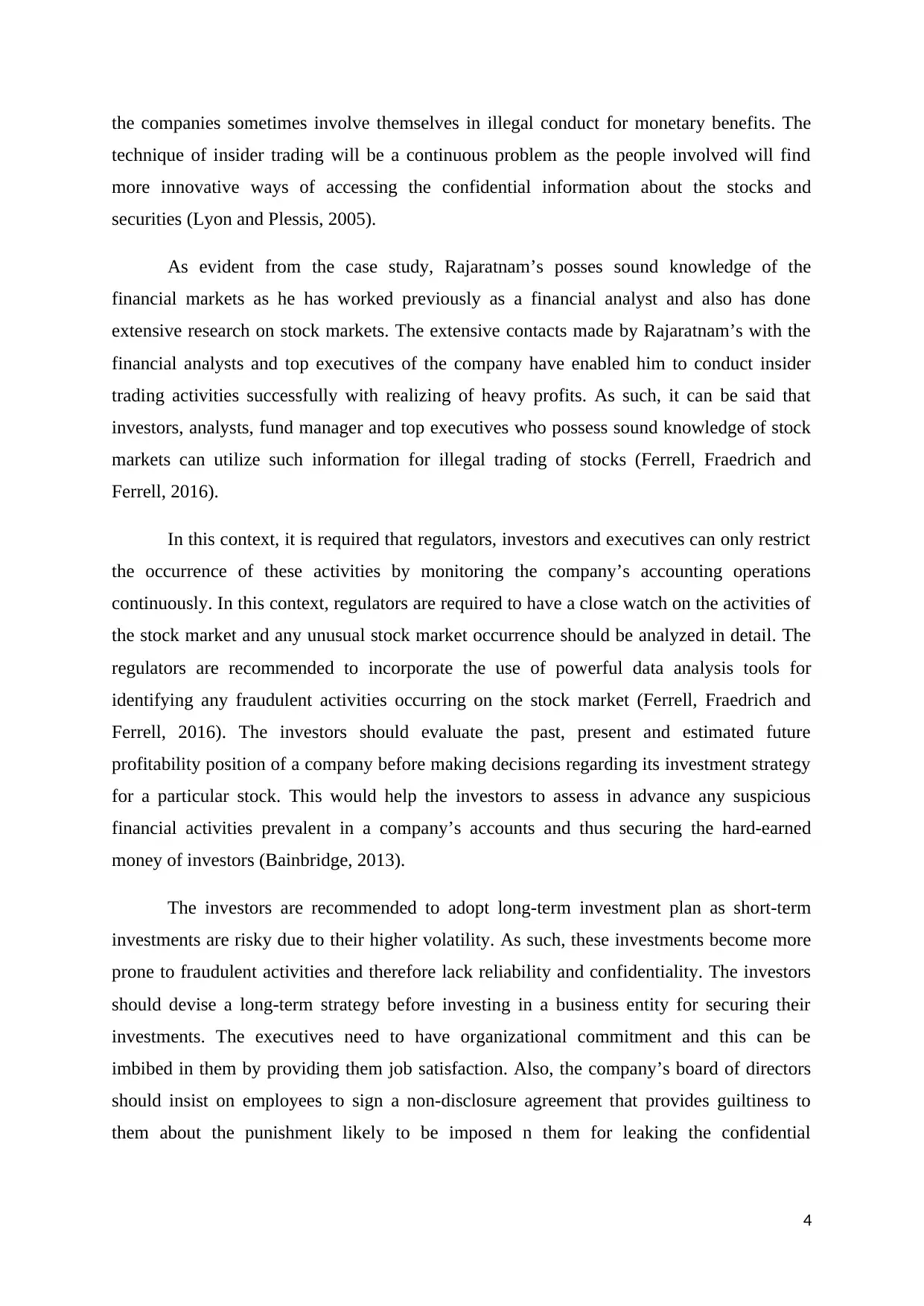
the companies sometimes involve themselves in illegal conduct for monetary benefits. The
technique of insider trading will be a continuous problem as the people involved will find
more innovative ways of accessing the confidential information about the stocks and
securities (Lyon and Plessis, 2005).
As evident from the case study, Rajaratnam’s posses sound knowledge of the
financial markets as he has worked previously as a financial analyst and also has done
extensive research on stock markets. The extensive contacts made by Rajaratnam’s with the
financial analysts and top executives of the company have enabled him to conduct insider
trading activities successfully with realizing of heavy profits. As such, it can be said that
investors, analysts, fund manager and top executives who possess sound knowledge of stock
markets can utilize such information for illegal trading of stocks (Ferrell, Fraedrich and
Ferrell, 2016).
In this context, it is required that regulators, investors and executives can only restrict
the occurrence of these activities by monitoring the company’s accounting operations
continuously. In this context, regulators are required to have a close watch on the activities of
the stock market and any unusual stock market occurrence should be analyzed in detail. The
regulators are recommended to incorporate the use of powerful data analysis tools for
identifying any fraudulent activities occurring on the stock market (Ferrell, Fraedrich and
Ferrell, 2016). The investors should evaluate the past, present and estimated future
profitability position of a company before making decisions regarding its investment strategy
for a particular stock. This would help the investors to assess in advance any suspicious
financial activities prevalent in a company’s accounts and thus securing the hard-earned
money of investors (Bainbridge, 2013).
The investors are recommended to adopt long-term investment plan as short-term
investments are risky due to their higher volatility. As such, these investments become more
prone to fraudulent activities and therefore lack reliability and confidentiality. The investors
should devise a long-term strategy before investing in a business entity for securing their
investments. The executives need to have organizational commitment and this can be
imbibed in them by providing them job satisfaction. Also, the company’s board of directors
should insist on employees to sign a non-disclosure agreement that provides guiltiness to
them about the punishment likely to be imposed n them for leaking the confidential
4
technique of insider trading will be a continuous problem as the people involved will find
more innovative ways of accessing the confidential information about the stocks and
securities (Lyon and Plessis, 2005).
As evident from the case study, Rajaratnam’s posses sound knowledge of the
financial markets as he has worked previously as a financial analyst and also has done
extensive research on stock markets. The extensive contacts made by Rajaratnam’s with the
financial analysts and top executives of the company have enabled him to conduct insider
trading activities successfully with realizing of heavy profits. As such, it can be said that
investors, analysts, fund manager and top executives who possess sound knowledge of stock
markets can utilize such information for illegal trading of stocks (Ferrell, Fraedrich and
Ferrell, 2016).
In this context, it is required that regulators, investors and executives can only restrict
the occurrence of these activities by monitoring the company’s accounting operations
continuously. In this context, regulators are required to have a close watch on the activities of
the stock market and any unusual stock market occurrence should be analyzed in detail. The
regulators are recommended to incorporate the use of powerful data analysis tools for
identifying any fraudulent activities occurring on the stock market (Ferrell, Fraedrich and
Ferrell, 2016). The investors should evaluate the past, present and estimated future
profitability position of a company before making decisions regarding its investment strategy
for a particular stock. This would help the investors to assess in advance any suspicious
financial activities prevalent in a company’s accounts and thus securing the hard-earned
money of investors (Bainbridge, 2013).
The investors are recommended to adopt long-term investment plan as short-term
investments are risky due to their higher volatility. As such, these investments become more
prone to fraudulent activities and therefore lack reliability and confidentiality. The investors
should devise a long-term strategy before investing in a business entity for securing their
investments. The executives need to have organizational commitment and this can be
imbibed in them by providing them job satisfaction. Also, the company’s board of directors
should insist on employees to sign a non-disclosure agreement that provides guiltiness to
them about the punishment likely to be imposed n them for leaking the confidential
4
Paraphrase This Document
Need a fresh take? Get an instant paraphrase of this document with our AI Paraphraser
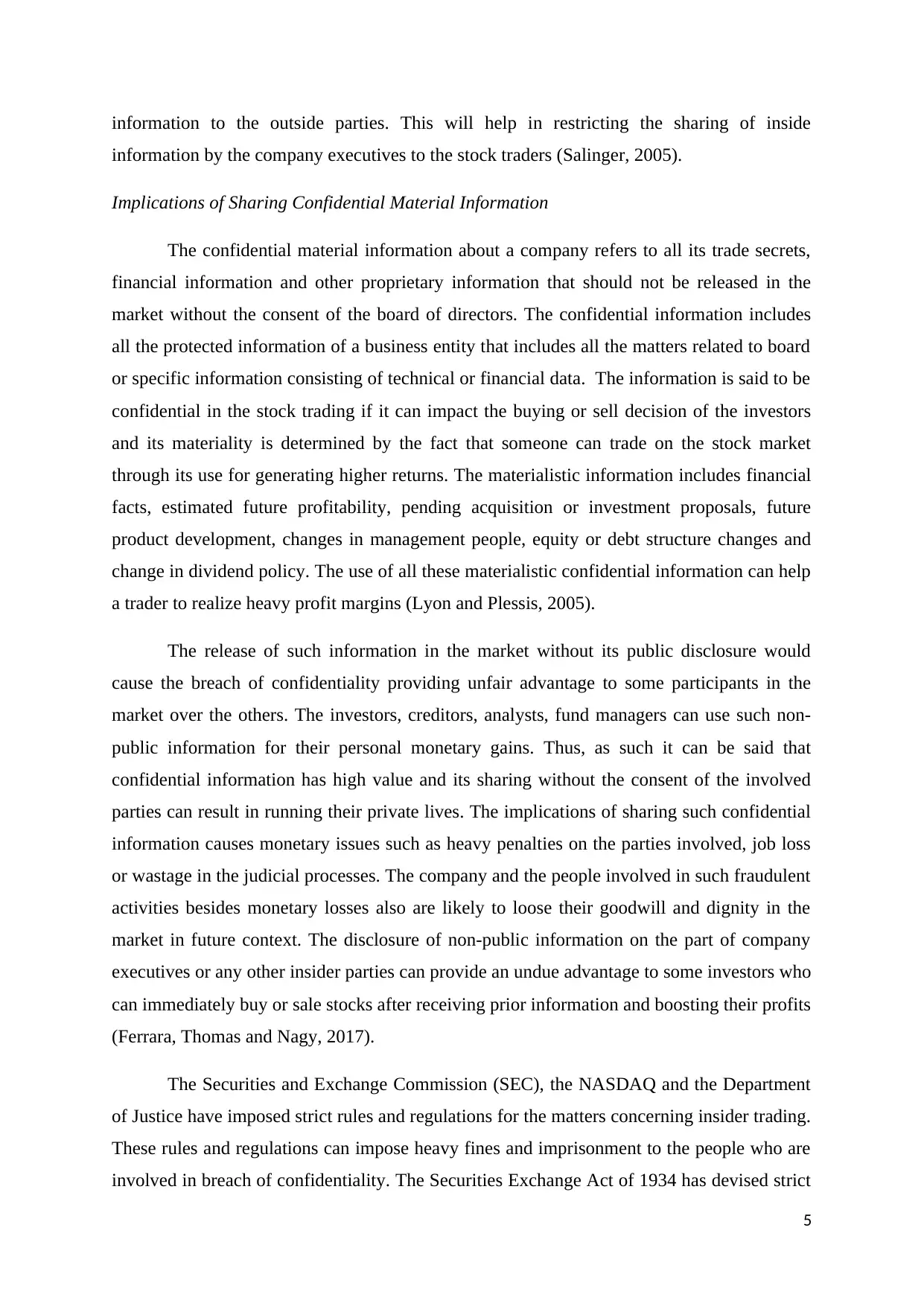
information to the outside parties. This will help in restricting the sharing of inside
information by the company executives to the stock traders (Salinger, 2005).
Implications of Sharing Confidential Material Information
The confidential material information about a company refers to all its trade secrets,
financial information and other proprietary information that should not be released in the
market without the consent of the board of directors. The confidential information includes
all the protected information of a business entity that includes all the matters related to board
or specific information consisting of technical or financial data. The information is said to be
confidential in the stock trading if it can impact the buying or sell decision of the investors
and its materiality is determined by the fact that someone can trade on the stock market
through its use for generating higher returns. The materialistic information includes financial
facts, estimated future profitability, pending acquisition or investment proposals, future
product development, changes in management people, equity or debt structure changes and
change in dividend policy. The use of all these materialistic confidential information can help
a trader to realize heavy profit margins (Lyon and Plessis, 2005).
The release of such information in the market without its public disclosure would
cause the breach of confidentiality providing unfair advantage to some participants in the
market over the others. The investors, creditors, analysts, fund managers can use such non-
public information for their personal monetary gains. Thus, as such it can be said that
confidential information has high value and its sharing without the consent of the involved
parties can result in running their private lives. The implications of sharing such confidential
information causes monetary issues such as heavy penalties on the parties involved, job loss
or wastage in the judicial processes. The company and the people involved in such fraudulent
activities besides monetary losses also are likely to loose their goodwill and dignity in the
market in future context. The disclosure of non-public information on the part of company
executives or any other insider parties can provide an undue advantage to some investors who
can immediately buy or sale stocks after receiving prior information and boosting their profits
(Ferrara, Thomas and Nagy, 2017).
The Securities and Exchange Commission (SEC), the NASDAQ and the Department
of Justice have imposed strict rules and regulations for the matters concerning insider trading.
These rules and regulations can impose heavy fines and imprisonment to the people who are
involved in breach of confidentiality. The Securities Exchange Act of 1934 has devised strict
5
information by the company executives to the stock traders (Salinger, 2005).
Implications of Sharing Confidential Material Information
The confidential material information about a company refers to all its trade secrets,
financial information and other proprietary information that should not be released in the
market without the consent of the board of directors. The confidential information includes
all the protected information of a business entity that includes all the matters related to board
or specific information consisting of technical or financial data. The information is said to be
confidential in the stock trading if it can impact the buying or sell decision of the investors
and its materiality is determined by the fact that someone can trade on the stock market
through its use for generating higher returns. The materialistic information includes financial
facts, estimated future profitability, pending acquisition or investment proposals, future
product development, changes in management people, equity or debt structure changes and
change in dividend policy. The use of all these materialistic confidential information can help
a trader to realize heavy profit margins (Lyon and Plessis, 2005).
The release of such information in the market without its public disclosure would
cause the breach of confidentiality providing unfair advantage to some participants in the
market over the others. The investors, creditors, analysts, fund managers can use such non-
public information for their personal monetary gains. Thus, as such it can be said that
confidential information has high value and its sharing without the consent of the involved
parties can result in running their private lives. The implications of sharing such confidential
information causes monetary issues such as heavy penalties on the parties involved, job loss
or wastage in the judicial processes. The company and the people involved in such fraudulent
activities besides monetary losses also are likely to loose their goodwill and dignity in the
market in future context. The disclosure of non-public information on the part of company
executives or any other insider parties can provide an undue advantage to some investors who
can immediately buy or sale stocks after receiving prior information and boosting their profits
(Ferrara, Thomas and Nagy, 2017).
The Securities and Exchange Commission (SEC), the NASDAQ and the Department
of Justice have imposed strict rules and regulations for the matters concerning insider trading.
These rules and regulations can impose heavy fines and imprisonment to the people who are
involved in breach of confidentiality. The Securities Exchange Act of 1934 has devised strict
5
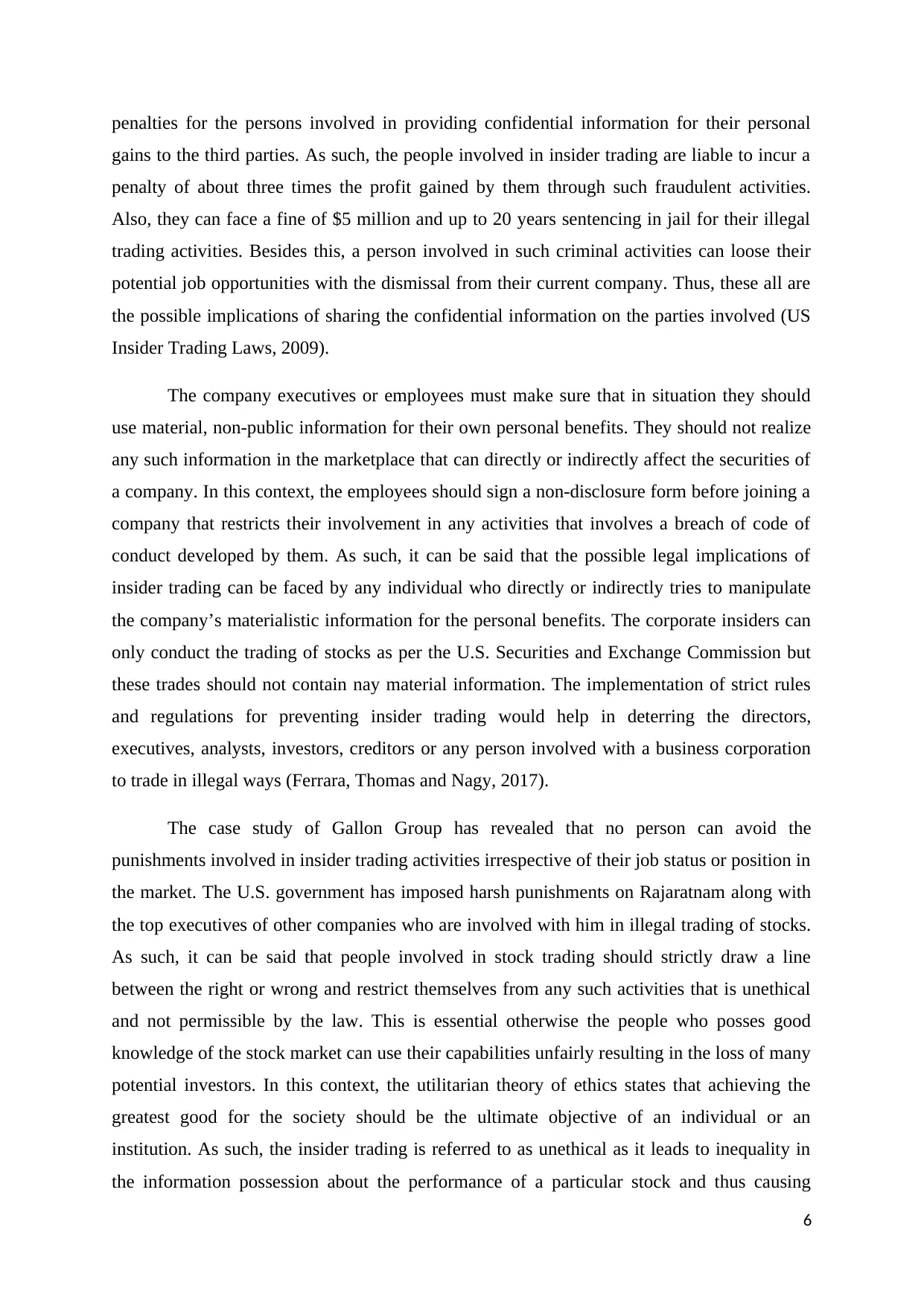
penalties for the persons involved in providing confidential information for their personal
gains to the third parties. As such, the people involved in insider trading are liable to incur a
penalty of about three times the profit gained by them through such fraudulent activities.
Also, they can face a fine of $5 million and up to 20 years sentencing in jail for their illegal
trading activities. Besides this, a person involved in such criminal activities can loose their
potential job opportunities with the dismissal from their current company. Thus, these all are
the possible implications of sharing the confidential information on the parties involved (US
Insider Trading Laws, 2009).
The company executives or employees must make sure that in situation they should
use material, non-public information for their own personal benefits. They should not realize
any such information in the marketplace that can directly or indirectly affect the securities of
a company. In this context, the employees should sign a non-disclosure form before joining a
company that restricts their involvement in any activities that involves a breach of code of
conduct developed by them. As such, it can be said that the possible legal implications of
insider trading can be faced by any individual who directly or indirectly tries to manipulate
the company’s materialistic information for the personal benefits. The corporate insiders can
only conduct the trading of stocks as per the U.S. Securities and Exchange Commission but
these trades should not contain nay material information. The implementation of strict rules
and regulations for preventing insider trading would help in deterring the directors,
executives, analysts, investors, creditors or any person involved with a business corporation
to trade in illegal ways (Ferrara, Thomas and Nagy, 2017).
The case study of Gallon Group has revealed that no person can avoid the
punishments involved in insider trading activities irrespective of their job status or position in
the market. The U.S. government has imposed harsh punishments on Rajaratnam along with
the top executives of other companies who are involved with him in illegal trading of stocks.
As such, it can be said that people involved in stock trading should strictly draw a line
between the right or wrong and restrict themselves from any such activities that is unethical
and not permissible by the law. This is essential otherwise the people who posses good
knowledge of the stock market can use their capabilities unfairly resulting in the loss of many
potential investors. In this context, the utilitarian theory of ethics states that achieving the
greatest good for the society should be the ultimate objective of an individual or an
institution. As such, the insider trading is referred to as unethical as it leads to inequality in
the information possession about the performance of a particular stock and thus causing
6
gains to the third parties. As such, the people involved in insider trading are liable to incur a
penalty of about three times the profit gained by them through such fraudulent activities.
Also, they can face a fine of $5 million and up to 20 years sentencing in jail for their illegal
trading activities. Besides this, a person involved in such criminal activities can loose their
potential job opportunities with the dismissal from their current company. Thus, these all are
the possible implications of sharing the confidential information on the parties involved (US
Insider Trading Laws, 2009).
The company executives or employees must make sure that in situation they should
use material, non-public information for their own personal benefits. They should not realize
any such information in the marketplace that can directly or indirectly affect the securities of
a company. In this context, the employees should sign a non-disclosure form before joining a
company that restricts their involvement in any activities that involves a breach of code of
conduct developed by them. As such, it can be said that the possible legal implications of
insider trading can be faced by any individual who directly or indirectly tries to manipulate
the company’s materialistic information for the personal benefits. The corporate insiders can
only conduct the trading of stocks as per the U.S. Securities and Exchange Commission but
these trades should not contain nay material information. The implementation of strict rules
and regulations for preventing insider trading would help in deterring the directors,
executives, analysts, investors, creditors or any person involved with a business corporation
to trade in illegal ways (Ferrara, Thomas and Nagy, 2017).
The case study of Gallon Group has revealed that no person can avoid the
punishments involved in insider trading activities irrespective of their job status or position in
the market. The U.S. government has imposed harsh punishments on Rajaratnam along with
the top executives of other companies who are involved with him in illegal trading of stocks.
As such, it can be said that people involved in stock trading should strictly draw a line
between the right or wrong and restrict themselves from any such activities that is unethical
and not permissible by the law. This is essential otherwise the people who posses good
knowledge of the stock market can use their capabilities unfairly resulting in the loss of many
potential investors. In this context, the utilitarian theory of ethics states that achieving the
greatest good for the society should be the ultimate objective of an individual or an
institution. As such, the insider trading is referred to as unethical as it leads to inequality in
the information possession about the performance of a particular stock and thus causing
6
⊘ This is a preview!⊘
Do you want full access?
Subscribe today to unlock all pages.

Trusted by 1+ million students worldwide
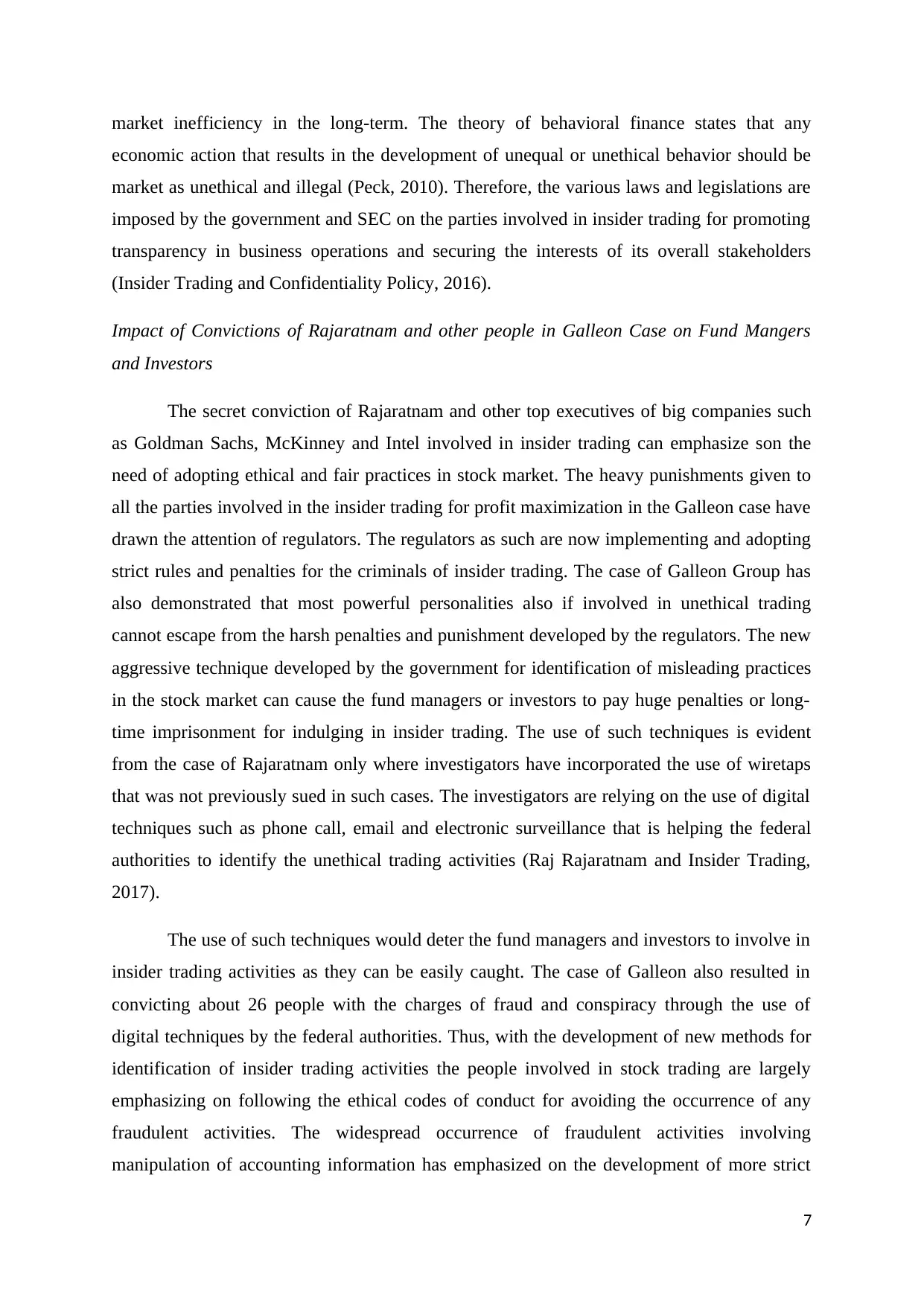
market inefficiency in the long-term. The theory of behavioral finance states that any
economic action that results in the development of unequal or unethical behavior should be
market as unethical and illegal (Peck, 2010). Therefore, the various laws and legislations are
imposed by the government and SEC on the parties involved in insider trading for promoting
transparency in business operations and securing the interests of its overall stakeholders
(Insider Trading and Confidentiality Policy, 2016).
Impact of Convictions of Rajaratnam and other people in Galleon Case on Fund Mangers
and Investors
The secret conviction of Rajaratnam and other top executives of big companies such
as Goldman Sachs, McKinney and Intel involved in insider trading can emphasize son the
need of adopting ethical and fair practices in stock market. The heavy punishments given to
all the parties involved in the insider trading for profit maximization in the Galleon case have
drawn the attention of regulators. The regulators as such are now implementing and adopting
strict rules and penalties for the criminals of insider trading. The case of Galleon Group has
also demonstrated that most powerful personalities also if involved in unethical trading
cannot escape from the harsh penalties and punishment developed by the regulators. The new
aggressive technique developed by the government for identification of misleading practices
in the stock market can cause the fund managers or investors to pay huge penalties or long-
time imprisonment for indulging in insider trading. The use of such techniques is evident
from the case of Rajaratnam only where investigators have incorporated the use of wiretaps
that was not previously sued in such cases. The investigators are relying on the use of digital
techniques such as phone call, email and electronic surveillance that is helping the federal
authorities to identify the unethical trading activities (Raj Rajaratnam and Insider Trading,
2017).
The use of such techniques would deter the fund managers and investors to involve in
insider trading activities as they can be easily caught. The case of Galleon also resulted in
convicting about 26 people with the charges of fraud and conspiracy through the use of
digital techniques by the federal authorities. Thus, with the development of new methods for
identification of insider trading activities the people involved in stock trading are largely
emphasizing on following the ethical codes of conduct for avoiding the occurrence of any
fraudulent activities. The widespread occurrence of fraudulent activities involving
manipulation of accounting information has emphasized on the development of more strict
7
economic action that results in the development of unequal or unethical behavior should be
market as unethical and illegal (Peck, 2010). Therefore, the various laws and legislations are
imposed by the government and SEC on the parties involved in insider trading for promoting
transparency in business operations and securing the interests of its overall stakeholders
(Insider Trading and Confidentiality Policy, 2016).
Impact of Convictions of Rajaratnam and other people in Galleon Case on Fund Mangers
and Investors
The secret conviction of Rajaratnam and other top executives of big companies such
as Goldman Sachs, McKinney and Intel involved in insider trading can emphasize son the
need of adopting ethical and fair practices in stock market. The heavy punishments given to
all the parties involved in the insider trading for profit maximization in the Galleon case have
drawn the attention of regulators. The regulators as such are now implementing and adopting
strict rules and penalties for the criminals of insider trading. The case of Galleon Group has
also demonstrated that most powerful personalities also if involved in unethical trading
cannot escape from the harsh penalties and punishment developed by the regulators. The new
aggressive technique developed by the government for identification of misleading practices
in the stock market can cause the fund managers or investors to pay huge penalties or long-
time imprisonment for indulging in insider trading. The use of such techniques is evident
from the case of Rajaratnam only where investigators have incorporated the use of wiretaps
that was not previously sued in such cases. The investigators are relying on the use of digital
techniques such as phone call, email and electronic surveillance that is helping the federal
authorities to identify the unethical trading activities (Raj Rajaratnam and Insider Trading,
2017).
The use of such techniques would deter the fund managers and investors to involve in
insider trading activities as they can be easily caught. The case of Galleon also resulted in
convicting about 26 people with the charges of fraud and conspiracy through the use of
digital techniques by the federal authorities. Thus, with the development of new methods for
identification of insider trading activities the people involved in stock trading are largely
emphasizing on following the ethical codes of conduct for avoiding the occurrence of any
fraudulent activities. The widespread occurrence of fraudulent activities involving
manipulation of accounting information has emphasized on the development of more strict
7
Paraphrase This Document
Need a fresh take? Get an instant paraphrase of this document with our AI Paraphraser
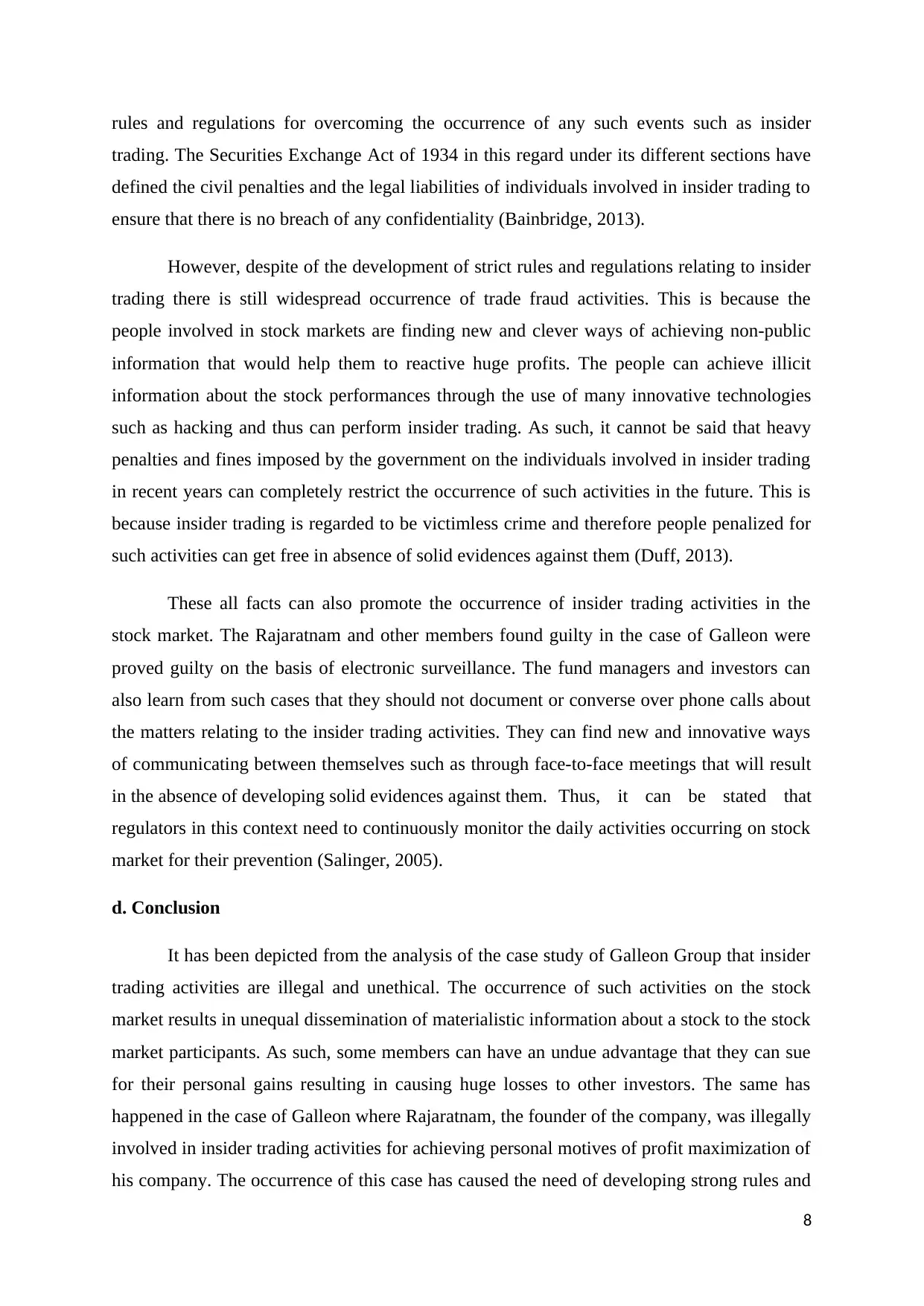
rules and regulations for overcoming the occurrence of any such events such as insider
trading. The Securities Exchange Act of 1934 in this regard under its different sections have
defined the civil penalties and the legal liabilities of individuals involved in insider trading to
ensure that there is no breach of any confidentiality (Bainbridge, 2013).
However, despite of the development of strict rules and regulations relating to insider
trading there is still widespread occurrence of trade fraud activities. This is because the
people involved in stock markets are finding new and clever ways of achieving non-public
information that would help them to reactive huge profits. The people can achieve illicit
information about the stock performances through the use of many innovative technologies
such as hacking and thus can perform insider trading. As such, it cannot be said that heavy
penalties and fines imposed by the government on the individuals involved in insider trading
in recent years can completely restrict the occurrence of such activities in the future. This is
because insider trading is regarded to be victimless crime and therefore people penalized for
such activities can get free in absence of solid evidences against them (Duff, 2013).
These all facts can also promote the occurrence of insider trading activities in the
stock market. The Rajaratnam and other members found guilty in the case of Galleon were
proved guilty on the basis of electronic surveillance. The fund managers and investors can
also learn from such cases that they should not document or converse over phone calls about
the matters relating to the insider trading activities. They can find new and innovative ways
of communicating between themselves such as through face-to-face meetings that will result
in the absence of developing solid evidences against them. Thus, it can be stated that
regulators in this context need to continuously monitor the daily activities occurring on stock
market for their prevention (Salinger, 2005).
d. Conclusion
It has been depicted from the analysis of the case study of Galleon Group that insider
trading activities are illegal and unethical. The occurrence of such activities on the stock
market results in unequal dissemination of materialistic information about a stock to the stock
market participants. As such, some members can have an undue advantage that they can sue
for their personal gains resulting in causing huge losses to other investors. The same has
happened in the case of Galleon where Rajaratnam, the founder of the company, was illegally
involved in insider trading activities for achieving personal motives of profit maximization of
his company. The occurrence of this case has caused the need of developing strong rules and
8
trading. The Securities Exchange Act of 1934 in this regard under its different sections have
defined the civil penalties and the legal liabilities of individuals involved in insider trading to
ensure that there is no breach of any confidentiality (Bainbridge, 2013).
However, despite of the development of strict rules and regulations relating to insider
trading there is still widespread occurrence of trade fraud activities. This is because the
people involved in stock markets are finding new and clever ways of achieving non-public
information that would help them to reactive huge profits. The people can achieve illicit
information about the stock performances through the use of many innovative technologies
such as hacking and thus can perform insider trading. As such, it cannot be said that heavy
penalties and fines imposed by the government on the individuals involved in insider trading
in recent years can completely restrict the occurrence of such activities in the future. This is
because insider trading is regarded to be victimless crime and therefore people penalized for
such activities can get free in absence of solid evidences against them (Duff, 2013).
These all facts can also promote the occurrence of insider trading activities in the
stock market. The Rajaratnam and other members found guilty in the case of Galleon were
proved guilty on the basis of electronic surveillance. The fund managers and investors can
also learn from such cases that they should not document or converse over phone calls about
the matters relating to the insider trading activities. They can find new and innovative ways
of communicating between themselves such as through face-to-face meetings that will result
in the absence of developing solid evidences against them. Thus, it can be stated that
regulators in this context need to continuously monitor the daily activities occurring on stock
market for their prevention (Salinger, 2005).
d. Conclusion
It has been depicted from the analysis of the case study of Galleon Group that insider
trading activities are illegal and unethical. The occurrence of such activities on the stock
market results in unequal dissemination of materialistic information about a stock to the stock
market participants. As such, some members can have an undue advantage that they can sue
for their personal gains resulting in causing huge losses to other investors. The same has
happened in the case of Galleon where Rajaratnam, the founder of the company, was illegally
involved in insider trading activities for achieving personal motives of profit maximization of
his company. The occurrence of this case has caused the need of developing strong rules and
8
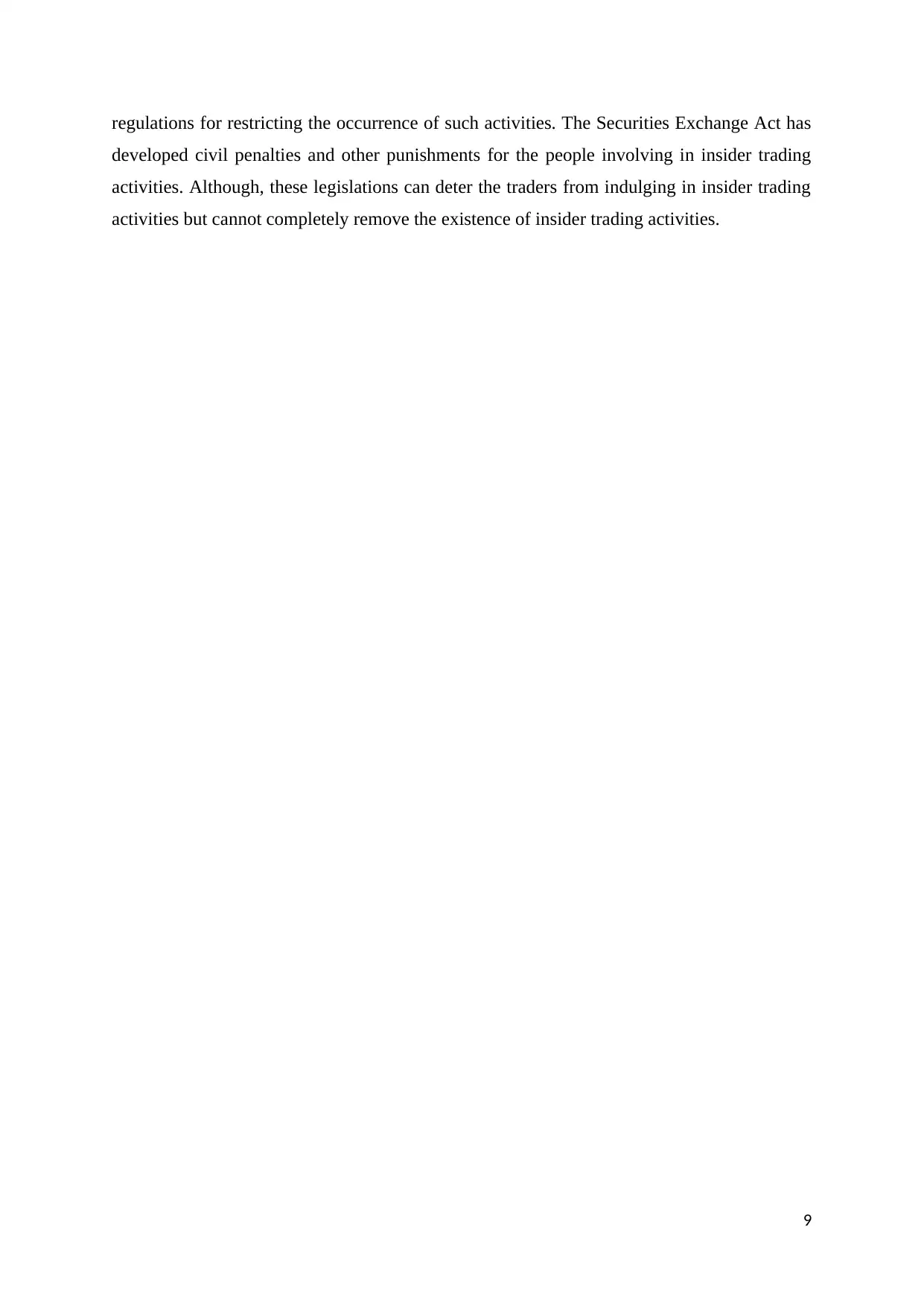
regulations for restricting the occurrence of such activities. The Securities Exchange Act has
developed civil penalties and other punishments for the people involving in insider trading
activities. Although, these legislations can deter the traders from indulging in insider trading
activities but cannot completely remove the existence of insider trading activities.
9
developed civil penalties and other punishments for the people involving in insider trading
activities. Although, these legislations can deter the traders from indulging in insider trading
activities but cannot completely remove the existence of insider trading activities.
9
⊘ This is a preview!⊘
Do you want full access?
Subscribe today to unlock all pages.

Trusted by 1+ million students worldwide
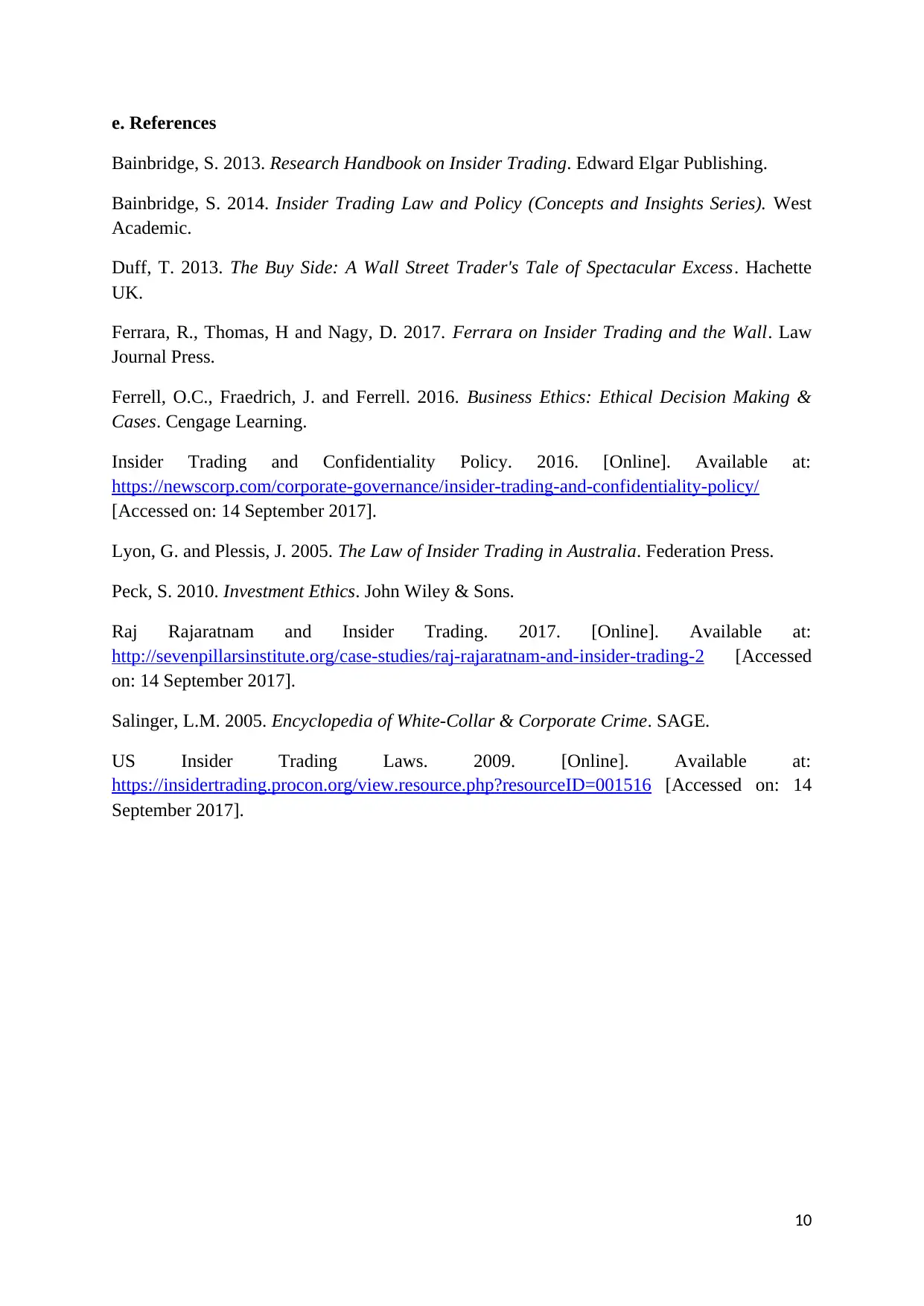
e. References
Bainbridge, S. 2013. Research Handbook on Insider Trading. Edward Elgar Publishing.
Bainbridge, S. 2014. Insider Trading Law and Policy (Concepts and Insights Series). West
Academic.
Duff, T. 2013. The Buy Side: A Wall Street Trader's Tale of Spectacular Excess. Hachette
UK.
Ferrara, R., Thomas, H and Nagy, D. 2017. Ferrara on Insider Trading and the Wall. Law
Journal Press.
Ferrell, O.C., Fraedrich, J. and Ferrell. 2016. Business Ethics: Ethical Decision Making &
Cases. Cengage Learning.
Insider Trading and Confidentiality Policy. 2016. [Online]. Available at:
https://newscorp.com/corporate-governance/insider-trading-and-confidentiality-policy/
[Accessed on: 14 September 2017].
Lyon, G. and Plessis, J. 2005. The Law of Insider Trading in Australia. Federation Press.
Peck, S. 2010. Investment Ethics. John Wiley & Sons.
Raj Rajaratnam and Insider Trading. 2017. [Online]. Available at:
http://sevenpillarsinstitute.org/case-studies/raj-rajaratnam-and-insider-trading-2 [Accessed
on: 14 September 2017].
Salinger, L.M. 2005. Encyclopedia of White-Collar & Corporate Crime. SAGE.
US Insider Trading Laws. 2009. [Online]. Available at:
https://insidertrading.procon.org/view.resource.php?resourceID=001516 [Accessed on: 14
September 2017].
10
Bainbridge, S. 2013. Research Handbook on Insider Trading. Edward Elgar Publishing.
Bainbridge, S. 2014. Insider Trading Law and Policy (Concepts and Insights Series). West
Academic.
Duff, T. 2013. The Buy Side: A Wall Street Trader's Tale of Spectacular Excess. Hachette
UK.
Ferrara, R., Thomas, H and Nagy, D. 2017. Ferrara on Insider Trading and the Wall. Law
Journal Press.
Ferrell, O.C., Fraedrich, J. and Ferrell. 2016. Business Ethics: Ethical Decision Making &
Cases. Cengage Learning.
Insider Trading and Confidentiality Policy. 2016. [Online]. Available at:
https://newscorp.com/corporate-governance/insider-trading-and-confidentiality-policy/
[Accessed on: 14 September 2017].
Lyon, G. and Plessis, J. 2005. The Law of Insider Trading in Australia. Federation Press.
Peck, S. 2010. Investment Ethics. John Wiley & Sons.
Raj Rajaratnam and Insider Trading. 2017. [Online]. Available at:
http://sevenpillarsinstitute.org/case-studies/raj-rajaratnam-and-insider-trading-2 [Accessed
on: 14 September 2017].
Salinger, L.M. 2005. Encyclopedia of White-Collar & Corporate Crime. SAGE.
US Insider Trading Laws. 2009. [Online]. Available at:
https://insidertrading.procon.org/view.resource.php?resourceID=001516 [Accessed on: 14
September 2017].
10
Paraphrase This Document
Need a fresh take? Get an instant paraphrase of this document with our AI Paraphraser
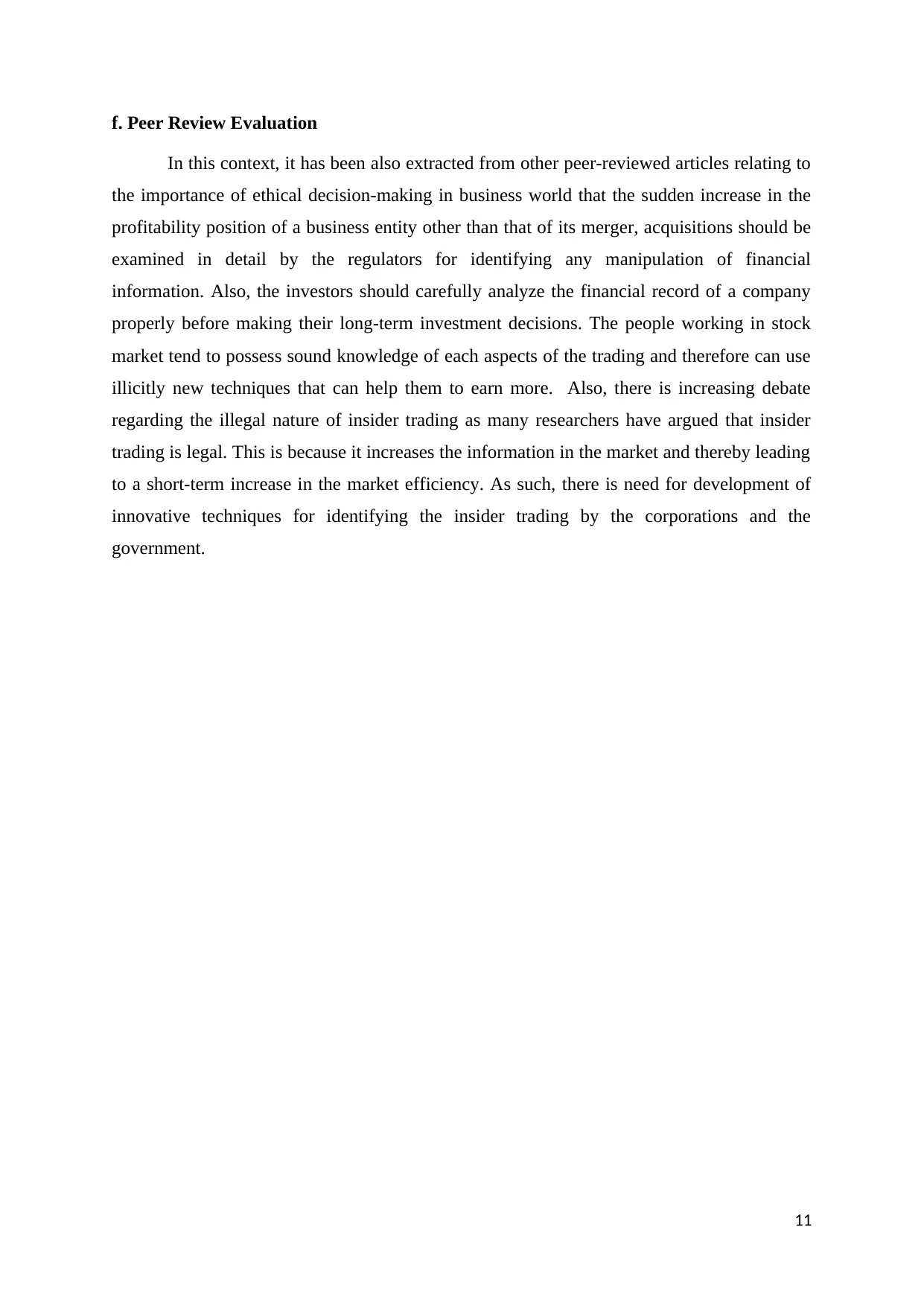
f. Peer Review Evaluation
In this context, it has been also extracted from other peer-reviewed articles relating to
the importance of ethical decision-making in business world that the sudden increase in the
profitability position of a business entity other than that of its merger, acquisitions should be
examined in detail by the regulators for identifying any manipulation of financial
information. Also, the investors should carefully analyze the financial record of a company
properly before making their long-term investment decisions. The people working in stock
market tend to possess sound knowledge of each aspects of the trading and therefore can use
illicitly new techniques that can help them to earn more. Also, there is increasing debate
regarding the illegal nature of insider trading as many researchers have argued that insider
trading is legal. This is because it increases the information in the market and thereby leading
to a short-term increase in the market efficiency. As such, there is need for development of
innovative techniques for identifying the insider trading by the corporations and the
government.
11
In this context, it has been also extracted from other peer-reviewed articles relating to
the importance of ethical decision-making in business world that the sudden increase in the
profitability position of a business entity other than that of its merger, acquisitions should be
examined in detail by the regulators for identifying any manipulation of financial
information. Also, the investors should carefully analyze the financial record of a company
properly before making their long-term investment decisions. The people working in stock
market tend to possess sound knowledge of each aspects of the trading and therefore can use
illicitly new techniques that can help them to earn more. Also, there is increasing debate
regarding the illegal nature of insider trading as many researchers have argued that insider
trading is legal. This is because it increases the information in the market and thereby leading
to a short-term increase in the market efficiency. As such, there is need for development of
innovative techniques for identifying the insider trading by the corporations and the
government.
11
1 out of 11
Related Documents
Your All-in-One AI-Powered Toolkit for Academic Success.
+13062052269
info@desklib.com
Available 24*7 on WhatsApp / Email
![[object Object]](/_next/static/media/star-bottom.7253800d.svg)
Unlock your academic potential
Copyright © 2020–2025 A2Z Services. All Rights Reserved. Developed and managed by ZUCOL.



